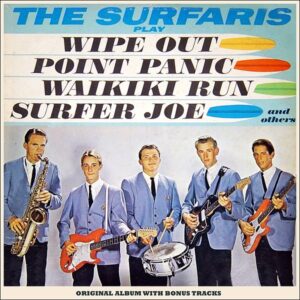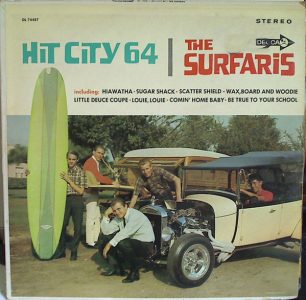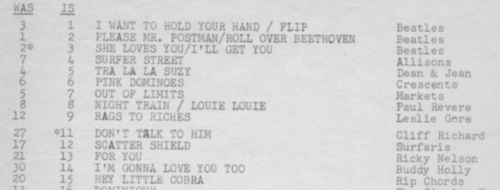#2: Scatter Shield by the Surfaris
City: Abbotsford, BC
Radio Station: CFUR
Peak Month: February 1964
Peak Position in Abbotsford ~ #9
Peak position in Vancouver ~ did not chart
Peak Position on Billboard Hot 100 ~ did not chart
YouTube: “Scatter Shield”
Ronald Lee Wilson was born in 1944 in Los Angeles. At the age of 17 he was a drummer in a high school band in Covina, California, called the Charter Oak Lancers. Bob Berryhill was born in 1947 in Glendora, California. When he was eight years old his parents bought an acoustic guitar which his Dad played. Bob got interested in guitars, and when he was 13 his parents took the family to Hawaii. It was there he saw a performer play a ukulele. When Berryhill returned home he went with his Dad to a music store and asked the staff to show him a ukulele. They told him they didn’t have any, but suggested he buy a guitar. Bob Berryhill soon began to play guitar and in eighth grade was entered in a talent contest. It was at the talent show that Berryhill heard the duo Pat Connolly and Jim Fuller. In fact, they borrowed Berryhill’s music equipment.
Connelly and Fuller subsequently got together and jammed at Berryhill’s house. Berryhill thought that was all that was going to happen, and thanked the pair for coming over to his house. But then, Jim Fuller asked Bob if he’d like to play with them at the concert they were doing at Pomona Catholic High School later that night. This was taking place after a football game, with the concert in the high school gym. In addition, Fuller and Connelly told Berryhill that they were going to be playing with a drummer they hadn’t heard play before. The drummer was Ron Wilson, and he was setting up his drums underneath the basketball net. And that was how the Surfaris first formed as a band in Glendora, California, in the spring of 1962.
Fuller and Connelly told Berryhill that the band’s manager was going to be Dale Smallin, who happened to have been Bob Berryhill’s Boy Scout leader when he was 12-years-old. Smallin got the band to practice regularly through the fall of 1962. By November they were booked to play some ‘Teen Centers” in Greater Los Angeles.
One night when the band was about to practice, Ron Wilson told Bob Berryhill that he had a dream about a song called Surfer Joe. Wilson had written five verses, and Berryhill helped with guitar accompaniment, as Wilson finished the song. They played it for Dale Smallin, who insisted that they record “Surfer Joe”. On the day in December ’62, when Smallin, Connolly, Fuller, Wilson and Berryhill met outside Berryhill’s home, they needed money. Dale Smallin told the bandmates that unless they could come up with $150 they would not be able to pay for the recording studio time. So Bob Berryhill talked to his mother who wrote Dale Smallin a check for $150, and off the Surfaris went to the recording studio. Instead of driving west to Hollywood, Smallin drove the band 19 miles east of Glendora to Cucamonga.
The recording was done on monaural. Ron Wilson sang the verses to “Surfer Joe” and the band thought they were finished. But the recording engineer told them they needed to have a B-side for the record. The Surfaris told him “we don’t have another song.” The engineer said they could put “Surfer Joe” on both the A-side and the B-side, or they could write another song. With that invitation, Ron Wilson began to play an infectious drum solo, and Fuller on lead guitar, Berryhill on rhythm guitar and Connolly on bass guitar quickly improvised. As the recording began, before the music started, Bob Berryhill recalls “My dad went out in the alley and picked up an old cement soaked piece of plywood, came back in and we broke it over a microphone to sound like a busting surf board.” This was followed by a maniacal laugh and the words “Wipe Out” spoken by band manager Dale Smallin.
The band played what they improvised through three times. Jim Fuller had gone to Tijuana the previous week and suggested they call it “Switchblade”. Another suggested “Busting Surfboards”, but there was already a song with that title. Dale Smallin offered up a maniacal laugh and then said “Wipe Out”. Smallin’s laugh and spoken word ‘Wipe Out’, ended up being on the beginning of the song. And “Wipe Out” became the title of the B-side.
The January 1963 recordings of “Surfer Joe” and “Wipe Out” on the DFS label were both about five minutes each in length. When the Surfaris were introduced to Princess Records in February ’63, the A-side “Surfer Joe” was shortened to 2:20 (leaving out a number of verses), and the B-side “Wipe Out” was shortened to 2:12. Princess Records said the disc wouldn’t get played on Top 40 AM radio unless the sides were edited.
However, when the Princess marketing and promotion team began to contact radio stations, they got nowhere. No one was interested in the Surfaris recording. One day two of the staff from Princess were at a diner in North Hollywood and the waitress asked the guys what they did for a living. They told her, and she said “have you got any good records I can send to a DJ I know named Johnny Hyde in Fresno, California.” Hyde was at KYNO-AM in Fresno. And the Princess promotions man said “yeah,” and he gave it to the waitress and she mailed “Surfer Joe”/”Wipe Out” to Johnny Hyde.
On KYNO, Johnny Hyde had a midnight show called Make It Or Break It, where they played new records. As Bob Berryhill tells it, “on midnight on a Tuesday night they [Hyde] played “Wipe Out”. And it became the fifth most important Record of the Night. They played it Wednesday and “Wipe Out” became number one, the first most important Record of the Night.” On the following day, “Thursday, a lawyer for Dot Records called Johnny Hyde and asked if he had any good records. And he [Hyde] said it got this one called “Wipe Out”. He [the Dot Records lawyer] says send it to me. So [Johnny Hyde] sends it to [Dot Records] North Hollywood.” The song got played “and Randy Woods, the president of Dot Records said that’s a hit. Call them [the Surfaris] in and we’ll sign them…. And then they came to my house in March of ’63 and had us sign contracts.”
At the time, Berryhill, Connolly and Fuller were 15-years-old, and Wilson was 17-years-old. As Dot was really good at promoting their records, both “Surfer Joe” and “Wipe Out” began to chart – separately and together – on various radio markets. The Dot Records release of “Surfer Joe” omitted the second and fifth verses of the song.
“Wipe Out” not only peaked at #2 in 1963, but returned to the Billboard Hot 100 in 1966 for another run up the chart to #16 in September. In 1963 “Wipe Out” was the number-fourteen song of the year, and in 1966 the number-fifty-five song of the year. In Vancouver (BC) “Wipe Out” appeared on the C-FUNTASTIC FIFTY on June 22, 1963. The single climbed to #6 in July and dropped to #8 on July 27, 1963. It likely would have continued to drop down the chart, except that the B-side, “Surfer Joe” started getting airplay. On August 3, 1963, both “Wipe Out” and “Surfer Joe” ranked #6 on the CFUN record survey. The following week the double-sided hit climbed to #3. But on August 17, “Surfer Joe” remained at #3, while “Wipe Out” – having enjoyed eight weeks on the chart, dropped off the record survey.
With their double-sided hit single, the Surfaris released the Wipe Out album. In November 1963, The Surfaris had a Top 50 hit with “Point Panic”, which peaked at #12 in Montreal, #49 on the Billboard Hot 100, #52 on the Cashbox Top 100 Singles chart, and #43 on the C-FUNTASTIC FIFTY in Vancouver. The single was in reference to a surfing venue in Hawaii, about six miles from Waikiki, and was a track from their second album, Play – with Decca Records.

A single was released ahead of Christmas titled “A Surfer’s Christmas List”, which made the Top 30 in San Jose, California. At the start of 1964, the Surfaris released the album Hit City 64.

And in January 1964, “Scatter Shield” was released. The instrumental was written by the band, and representative of a lot of the instrumental tracks found in the soundtracks for teen beach and surf films in the 1960s. The single climbed to #9 in Abbotsford (BC) and #12 in Chilliwack (BC).
The B-side of the single, “I Wanna Take A Trip To The Islands”, climbed to #18 in Vancouver on CFUN. The single featured vocals by Ron Wilson. These tracks were from the band’s third album Hit City ’64.
The Surfaris were invited to perform on tour in Hawaii and across the United States. In January-February 1964, the Surfaris toured across Japan, Australia and New Zealand. While on various tours, The Surfaris shared the stage with The Beach Boys, Roy Orbison, Jan & Dean, The Righteous Brothers, The Turtles, Jay and The Americans, The Crystals, Bobby Vinton, Paul Revere and The Raiders, Dick Dale, and The Ventures. Later in 1964 the Surfaris recorded music for the film The Lively Set, starring James Darren and Joanie Sommers.
In 1965, as the British Invasion marched on, the Surfaris left surf music and recorded folk rock. In that vein, they and had a #2 hit in Japan with a song titled “Kareen”. By 1965 Ron Wilson had developed into an accomplished lead singer and with Ken Forssi replacing Pat Connolly on bass guitar. The Surfaris completed a promising but ultimately failed recording of Boy Dylan‘s “It Ain’t Me Babe”. The Surfaris sixth studio album, It Ain’t Me Babe, was released in 1965. Now the band was doing covers of Bob Dylan’s “Like A Rolling Stone” and “All I Really Want To Do“, the We Five folk song “You Were On My Mind”, Billy Joe Royal’s “Down In The Boondocks”, the Beach Boys “California Girls”, Ian Whitcomb’s “You Turn Me On”, the Rolling Stones “(I Can’t Get No) Satisfaction” and the Johnny Kidd and the Pirates/Guess Who? cover of “Shakin’ All Over“.
“Wipe Out” enjoyed a resurgence in 1966 and the band remained together. “Wipe Out” climbed back up to #16 on the Billboard Hot 100, though it did not re-chart again in Vancouver (BC). And “Surfer Joe” had some chart action after 1963, peaking at #1 in Miami in July 1965, #7 in Manchester (NH) in August 1965, and #8 in Salinas, California, in July 1966.
In late 1966 the Surfaris disbanded. A final single titled “Search”/”Shake” was released on Dot Records in April 1967. Fossi went on to join the psychedelic rock band called Love. They reformed in 1973 and again in 1976, before performing with several of the original members from the 1980s (Ron Wilson died in 1989, and Jim Fuller in 2017) to the present – with Bob Berryhill the surviving member. (Pat Connolly had left the band in ’65). Over the years the Surfaris have also shared the concert stage with Frankie Avalon, The Diamonds, Johnny Maestro and the Brooklyn Bridge, The Marcels, The Tokens, The Kingsmen and Herman’s Hermits.
Ron Wilson and the Surfaris appeared in concert two nights in a row in Vancouver (BC) in 1987. Then Ron Wilson died after suffering a brain aneurysm in May of 1989.
In 2013 the Surfaris released an album titled The Surfaris: The Original Hit Versions! – Wipe Out and Surfer Joe: 50th Anniversary 1963-2013. And in 2015 the Surfaris released The Surfaris: Hurley Sessions, recorded at Hurley Studios in Costa Mesa, California. In 2017, Jim Fuller died at the age of 69 on Monrovia, California, just 9 miles northwest of the high school he attended in Corvina. As of 2023, Bob Berryhill’s Surfaris continues to be an active concert band.
November 4, 2023
Ray McGinnis
References:
“Jim Fuller, ‘Wipe Out’ Guitarist with Surfaris, Dies,” Best Classic Bands.com, March 20, 2017.
“The Surfaris – Surfer Joe/Wipe Out 1962 Original DFS 45 Surf Garage,” Popsike.com.
“Former Sacramento Radio DJ Johnny Hyde Recalls his Storied Career,” Valley Community Newspaper, Sacramento, CA, November 16, 2014.
“Ron Wilson & The Surfaris,” Vancouver, BC, 1987.
Gary James, “The Surfaris,” Classic Bands.com.
“Our History,” Surfingwalkoffame.com.
“Why is Huntington Beach called Surf City USA?,” Surfertoday.com.

CFUR 1240-AM, Abbotsford (BC), Top 15 February 8, 1964

Leave a Reply